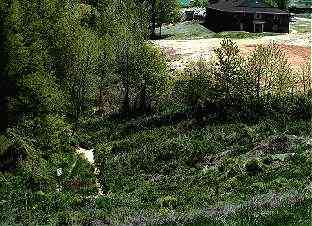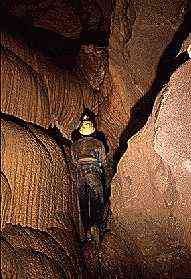Development in Karstlands
 More and more, the hazards facing cave systems lie not in the individual actions of adjacent landowners or vandals, but in residential and commercial development. Karst is particularly vulnerable to damage from urban sprawl. Erosion during construction silts up cave passage, and road salt or leaking underground storage tanks pollute cave waters. County planners sometimes cut corners when faced with the expense of extending sewage treatment facilities. Drilling activities may penetrate caves, introducing foreign materials into the cave environment. Since these impacts are underground, all too often little thought is given to them.
More and more, the hazards facing cave systems lie not in the individual actions of adjacent landowners or vandals, but in residential and commercial development. Karst is particularly vulnerable to damage from urban sprawl. Erosion during construction silts up cave passage, and road salt or leaking underground storage tanks pollute cave waters. County planners sometimes cut corners when faced with the expense of extending sewage treatment facilities. Drilling activities may penetrate caves, introducing foreign materials into the cave environment. Since these impacts are underground, all too often little thought is given to them.
Developers were allowed to construct the building at top right on the side of a blind valley which feeds rainwater into a large cave system (the entrance is near the sign at lower left). Mud and silt deposits are clearly seen on the valley floor, and more silt washed into this cave with every rainfall. This situation continued for months without the developers making any attempt at erosion control.
 The other photos on this page came from another large system in Lawrence county. This cave once contained a significant population of blind cave fish. Unfortunately, a leaking underground storage tank from a local service station introduced gasoline into the system. The status of the cave fish is unknown.
The other photos on this page came from another large system in Lawrence county. This cave once contained a significant population of blind cave fish. Unfortunately, a leaking underground storage tank from a local service station introduced gasoline into the system. The status of the cave fish is unknown.
These are clearly examples of gross neglect, but in other cases it can be difficult for developers to determine if sensitive resources exist in the vicinity. Cave location data is a key ingredient to ensure their protection. The Indiana Cave Survey has the most extensive database of karst features in the state. The IKC is working closely with the ICS, The Nature Conservancy, and state and federal agencies; developing ways to share this information "as needed" while retaining its confidentiality. The IKC also worked to strengthen gas drilling permit requirements in an attempt to reduce the chance that wells will penetrate known cave passage.
Cave photos courtesy S Frushour / Indiana Cave Survey

